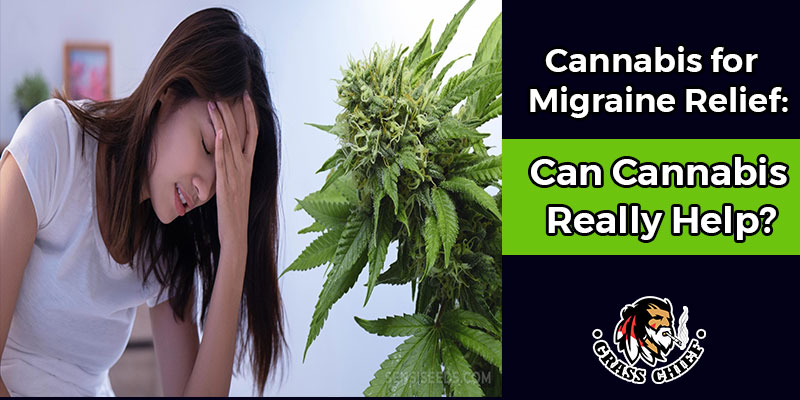Cannabis, Health, Medical Marijuana
Cannabis for Migraine Relief: Can Cannabis Really Help?
Introduction
Treatment options for migraine headaches are limited due to medical reasons. Is there anything more you may try if no over-the-counter or prescription medication helps your pain, nausea, or sensitivity to sunlight or noise? In some instances, Marijuana might be used as an over-the-counter treatment for migraines. Evidence suggests that it may reduce migraine pain and even prevent new attacks. However, most investigations have failed to provide convincing evidence of that.
Also, purchasing, cultivating, possessing, or using cannabis is illegal in several places, even for medicinal purposes. Check the laws in your state to see whether you may legally do this.
What is Migraine?
Nausea, vomiting, sensitivity to light and sound, and other symptoms define migraine as a distinct clinical illness rather than just a kind of headache.
Nevertheless, migraine is the second most prevalent neurological illness worldwide and the primary source of disability in those under 50. It is projected that 20.5% of women and 9.6% of men in the U.S suffer from migraines. Worldwide, over 1 billion individuals are affected by migraines.
A migraine headache is characterized by one-sidedness and pulsating pain; this kind of headache is known as a migraine. A migraine involving aura is a headache disorder characterized by a cluster of symptoms thought to originate in the brain. Aura symptoms often begin 20-30 minutes before the onset of a headache.
What Are The Symptoms of Migraine?
Headaches are often the first sign of a migraine. Words like “pounding” or “throbbing” often express pain. It may start as a slight ache and then progress to pulsating pain that is light, moderate, or intense. A mild to severe headache can worsen if you don’t have it checked out. It’s possible to have pain that originates in different parts of your skull, moves from side to side, or seems to radiate throughout your whole head. Pain may develop in various locations, including the sinuses, jaw, neck, and area surrounding the eye or temple.
Migraine headaches also cause the following symptoms:
- Irritation by exposure to bright or loud environments or strong scents
- Discomfort and discomfort in the abdomen, nausea, and vomiting
- Reduced hunger
- Extreme heat (sweat)
- White or very light-colored skin
- Intense wooziness and hazy perception
- Scalp, that’s easy to hurt
- Diarrhea
- Fever
What Are The Causes Of Migraine?
Migraine headaches are a complex and poorly understood origin. Specific nerves within your blood vessels transmit pain receptors to your brain, causing headaches. This triggers the release of inflammatory molecules into the head’s blood vessels and nerves. Unfortunately, no one can explain why your nerves are acting up like that.
Many things may set off a migraine episode. Common precipitants include:
- Psychological strain: Migraine headaches are often triggered by emotional stress. Some chemicals located in the brain deal with stressful situations. When these substances are released, they might trigger migraine symptoms.
- Intolerance to certain food additives and preservatives: Up to 30 percent of migraines may be brought on by eating or drinking certain things, such as alcoholic drinks and food additives like nitrates.
- Caffeine: When the body’s caffeine supply suddenly runs out, headaches may result from either overuse or withdrawal. In addition, when you don’t obtain your daily dose of caffeine, your blood vessels may get hypersensitive and cause you to have a headache.
- Taking painkillers regularly: Frequent use of pain relievers for headaches might lead to rebound headaches.
- Hormonal shifts in females: Women tend to suffer from migraines more often throughout their menstrual cycles. Migraines are sometimes brought on by the sudden reduction in estrogen that ushers in menstruation. Birth control medications and HRT may also cause hormonal shifts.
- Light: Light from sources such as the television, computer screen, sunlight, and fluorescent bulbs may set you off.
Cannabis For Migraine Treatment Research
Dr. Cecilia Rosales, a member of the research team and associate dean at the University of Arizona’s School of Public Health, stated that the purpose of the study was to determine the efficacy and safety of Medical Marijuana for migraine.
Rosales and her colleagues looked at 12 previous studies with roughly 2,000 individuals in the United States and Italy who were 18 or older.
After reviewing the available literature, the researchers concluded that medicinal cannabis was around 60% more effective than non-cannabis therapies in attaining migraine relief. In addition, migraine days and monthly migraine frequency decreased in persons who took medicinal cannabis.
Dr. Sherry Yafai, an expert in emergency care and cannabis who works at Providence Saint John’s Health Clinic in California, is pleased with the growing evidence supporting cannabis’ therapeutic potential.
She told MNT, “Just as in this review research, we’re finding a very similar reaction in patients we’re treating as well,” in that patients’ migraine headaches last less long. “Their days-to-weeks-long headaches, based on when they treat with cannabis usage, endure just hours.”
What’s The Best Way to Take Medical Marijuana?
Cannabis and pain relief’s numerous benefits are that it may be used medicinally in many ways.
Ingest via Eating
Eating cannabis is among the safest methods to medication, however users should be aware that the drug’s effects may be more substantial, the onset may be prolonged by an hour or more, and the results may persist longer than with inhalation alone.
Apply via Topicals
Some aches and pains may respond best to this method of medication administration because it is among the safest. Applying cannabis products topically will not have any intoxicating effect.
Inhale via Smoking
It’s a convenient method for getting fast relief and figuring out what dosage works best because of how soon you feel the benefits. Although studies have proved that smoking marijuana does not increase the likelihood of lung or other malignancies, inhaling tars and other possible irritants may induce unpleasant bronchial symptoms like hard coughing.
Inhale via Vaporizer
This is the most secure method of inhaling your medication since it vaporizes the cannabinoid-rich oils without burning the rest of the plant, decreasing exposure to harmful tars or other chemical irritants. As a bonus, vaporizers are much less odorous than traditional smoking methods.
Is Sativas Better for Migraines?
Undoubtedly sativas provide a different problem. Do they help with headaches? Of course, but that’s not to say it couldn’t be. Some people feel that smoking something like a Sativa hybrid within the first indication of a migraine is the ideal preventive approach. Some people think they’re too strong of a stimulant and will make you hyperactive.
Effective Strains for Migraines
The chemical makeup of cannabis varies significantly across strains; consult your local budtender for assistance finding the right strain for your needs.
OG KUSH
This strain is a household name for relieving pain and is widely available at legal retailers. This combination has a high THC level and is often used as a sedative, so it might provide the quick comfort you need right now.
WHITE WIDOW
White Widow’s strong kief production makes it one of the most potent hybrids, and its citrusy flavor is renowned for its ability to relieve headache pain while still providing a pleasant high.
BLUE DREAM
Blue Dream is a popular hybrid because of its high myrcene and pinene content. This strain is excellent for migraine sufferers since it provides bodily relaxation and a stimulating head high.
HARLEQUIN
Try a Cannabidiol strain like Harlequin if the effects of THC-rich strains like Blue Dream or Haze are too intense. This Sativa-dominant hybrid has high concentrations of the anti-inflammatory terpenes pinene and caryophyllene, which may be the source of your migraine headache.
What about Other Migraine Treatments?
Evidence is strongest for using non-steroidal anti-inflammatory medications (NSAIDs), which are standard treatment options. In addition, evidence of effectiveness from double-blind randomized controlled trials is available for ibuprofen, acetylsalicylic acid, naproxen sodium and diclofenac potassium, and has been analyzed in systematic reviews.
Acetaminophen and acetaminophen/caffeine/aspirin combinations have also shown consistent evidence of effectiveness for treating acute migraine.
BOTTOM LINE
The fact that many people report feeling better after using cannabis for migraines suggests that there may be something to the anecdotal claims that it helps. But if you’re just getting your feet wet in the ocean of medical Marijuana, take it calm and easy.

